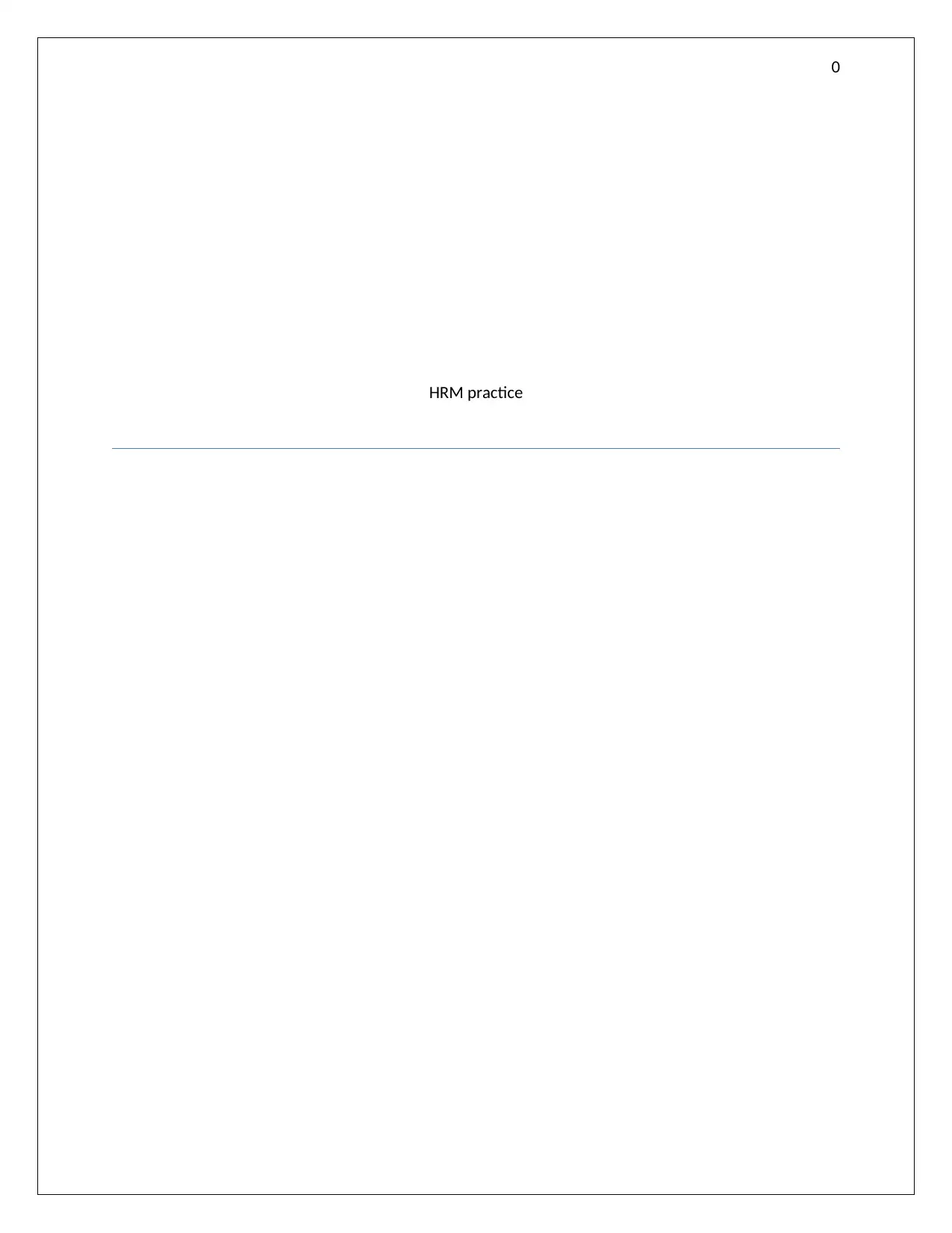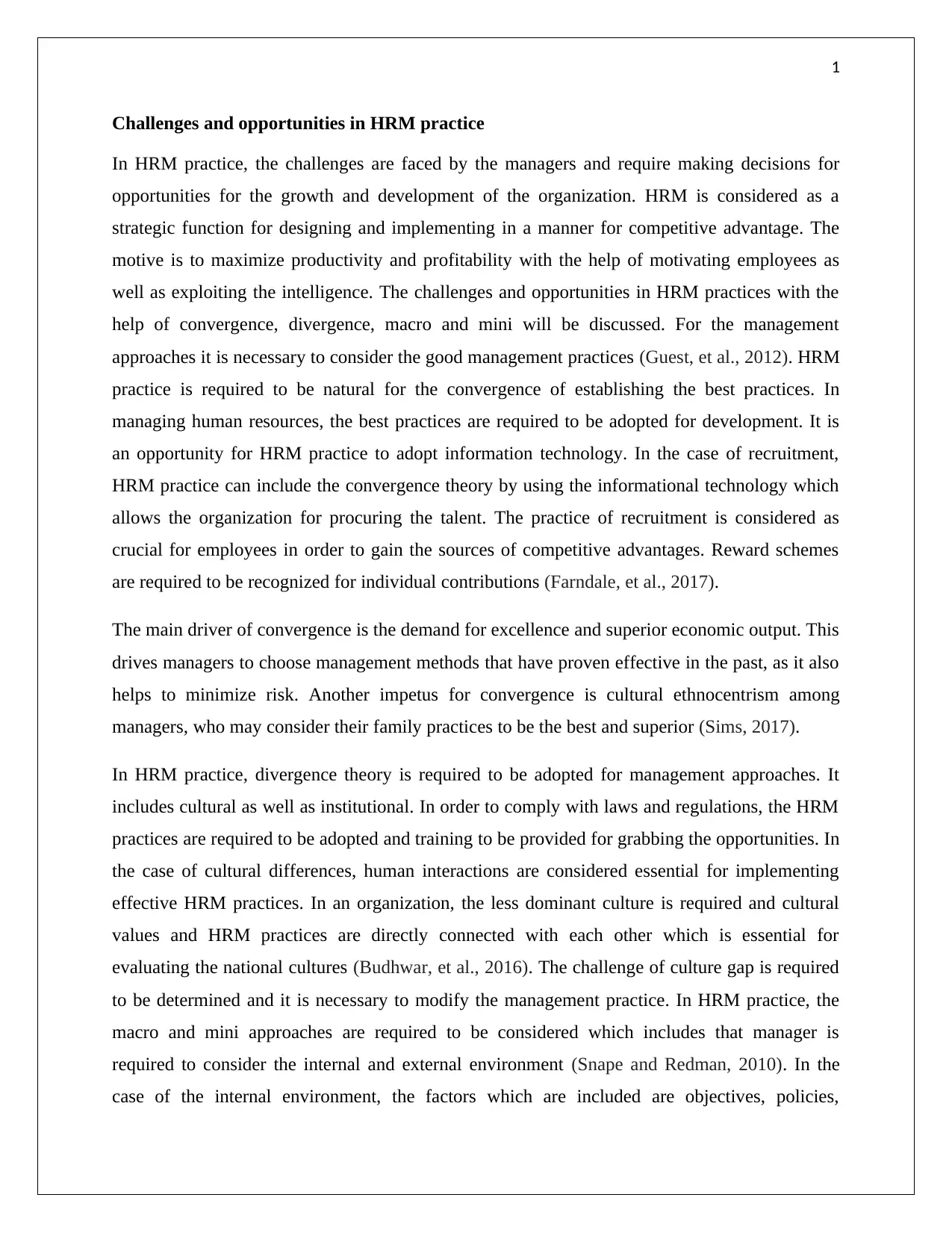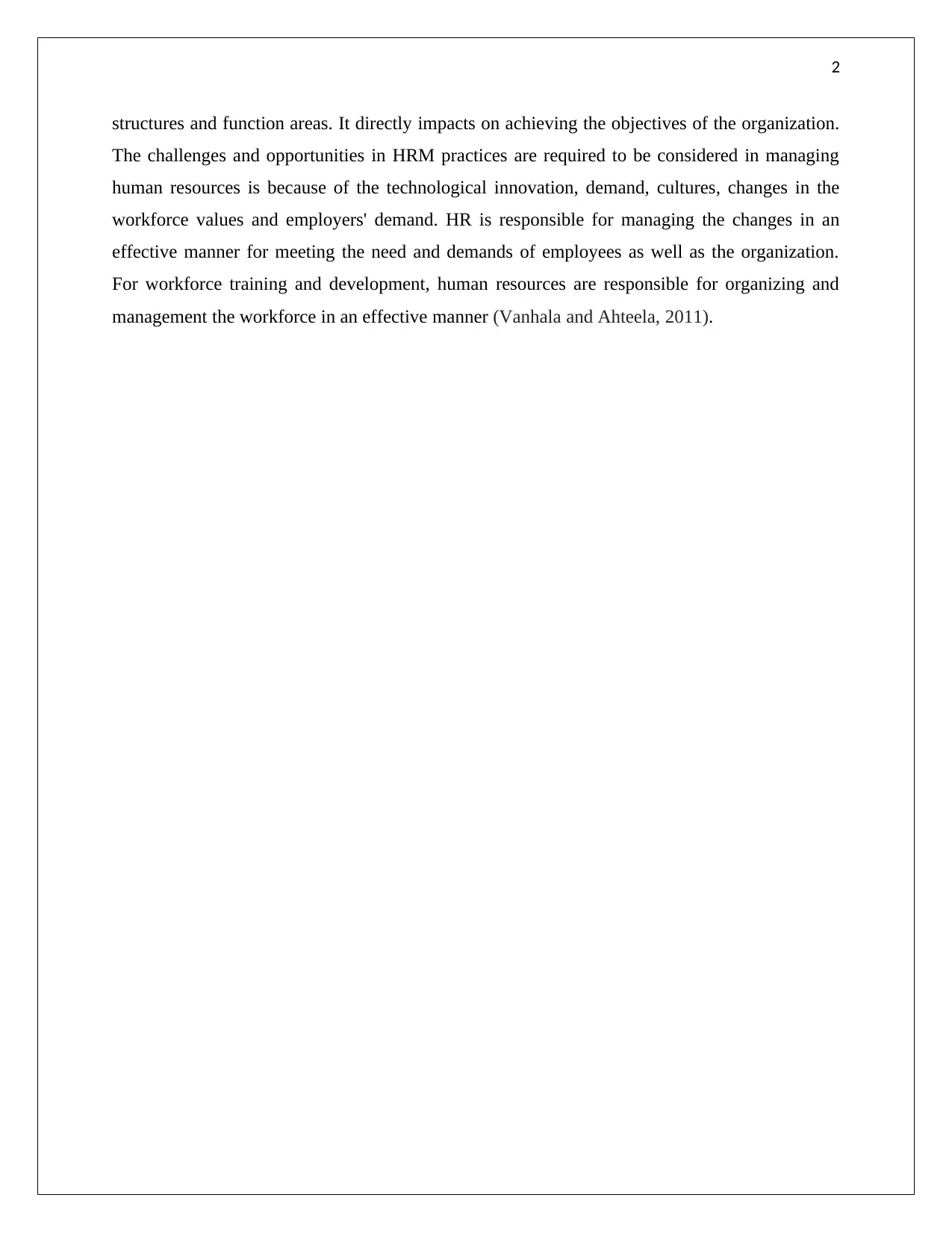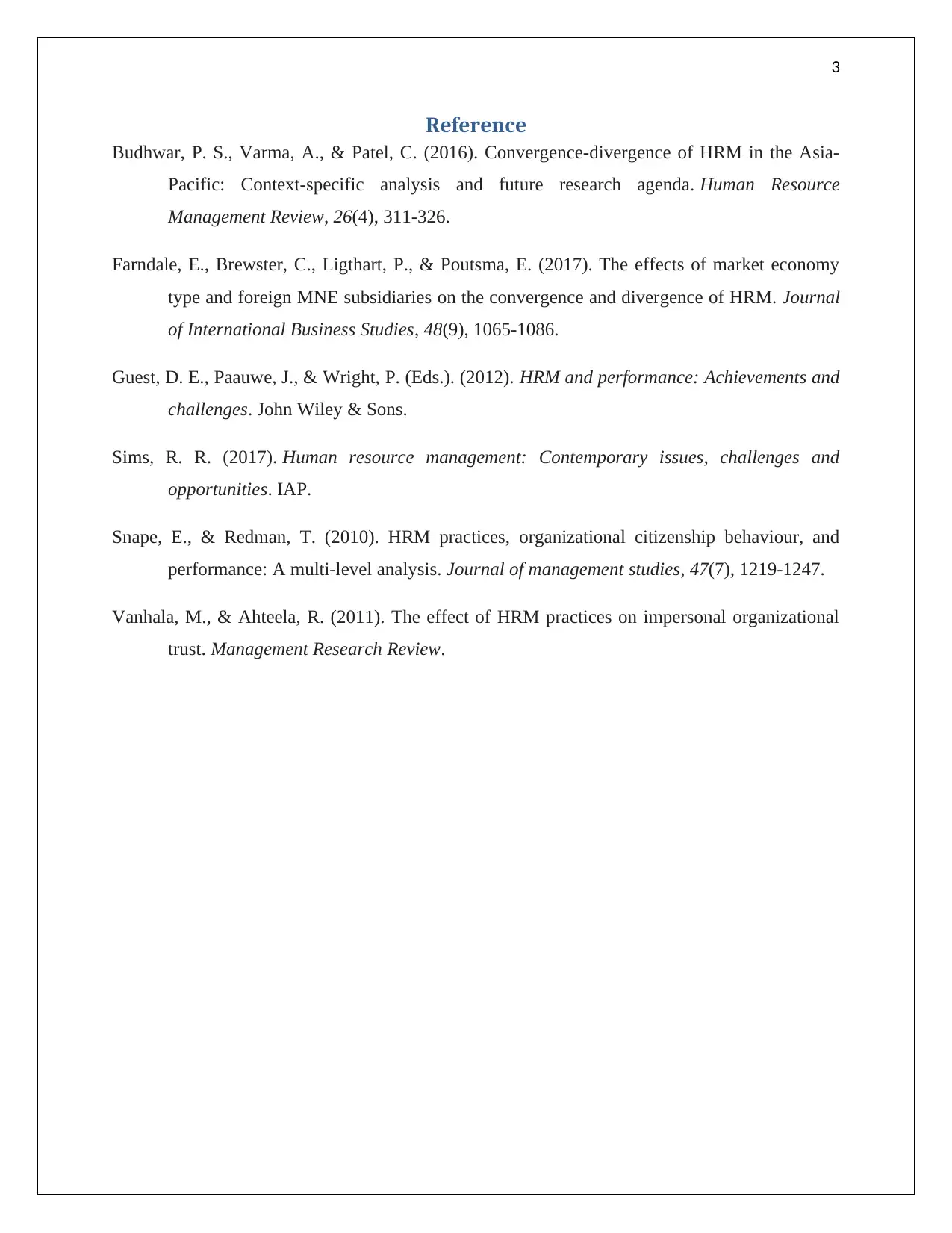HRM Practice: Challenges and Opportunities Analysis Report
VerifiedAdded on 2022/08/18
|4
|796
|47
Report
AI Summary
This report examines the challenges and opportunities within Human Resource Management (HRM) practices. It explores the convergence and divergence theories, highlighting how organizations adapt to best practices and cultural differences. The report discusses the application of macro and mini approaches, considering both internal and external environmental factors. It emphasizes the importance of HRM in responding to technological innovation, changing workforce values, and employer demands, particularly in workforce training and development. The analysis includes references to various academic sources, providing a well-rounded overview of the subject matter.

0
HRM practice
HRM practice
Paraphrase This Document
Need a fresh take? Get an instant paraphrase of this document with our AI Paraphraser

1
Challenges and opportunities in HRM practice
In HRM practice, the challenges are faced by the managers and require making decisions for
opportunities for the growth and development of the organization. HRM is considered as a
strategic function for designing and implementing in a manner for competitive advantage. The
motive is to maximize productivity and profitability with the help of motivating employees as
well as exploiting the intelligence. The challenges and opportunities in HRM practices with the
help of convergence, divergence, macro and mini will be discussed. For the management
approaches it is necessary to consider the good management practices (Guest, et al., 2012). HRM
practice is required to be natural for the convergence of establishing the best practices. In
managing human resources, the best practices are required to be adopted for development. It is
an opportunity for HRM practice to adopt information technology. In the case of recruitment,
HRM practice can include the convergence theory by using the informational technology which
allows the organization for procuring the talent. The practice of recruitment is considered as
crucial for employees in order to gain the sources of competitive advantages. Reward schemes
are required to be recognized for individual contributions (Farndale, et al., 2017).
The main driver of convergence is the demand for excellence and superior economic output. This
drives managers to choose management methods that have proven effective in the past, as it also
helps to minimize risk. Another impetus for convergence is cultural ethnocentrism among
managers, who may consider their family practices to be the best and superior (Sims, 2017).
In HRM practice, divergence theory is required to be adopted for management approaches. It
includes cultural as well as institutional. In order to comply with laws and regulations, the HRM
practices are required to be adopted and training to be provided for grabbing the opportunities. In
the case of cultural differences, human interactions are considered essential for implementing
effective HRM practices. In an organization, the less dominant culture is required and cultural
values and HRM practices are directly connected with each other which is essential for
evaluating the national cultures (Budhwar, et al., 2016). The challenge of culture gap is required
to be determined and it is necessary to modify the management practice. In HRM practice, the
macro and mini approaches are required to be considered which includes that manager is
required to consider the internal and external environment (Snape and Redman, 2010). In the
case of the internal environment, the factors which are included are objectives, policies,
Challenges and opportunities in HRM practice
In HRM practice, the challenges are faced by the managers and require making decisions for
opportunities for the growth and development of the organization. HRM is considered as a
strategic function for designing and implementing in a manner for competitive advantage. The
motive is to maximize productivity and profitability with the help of motivating employees as
well as exploiting the intelligence. The challenges and opportunities in HRM practices with the
help of convergence, divergence, macro and mini will be discussed. For the management
approaches it is necessary to consider the good management practices (Guest, et al., 2012). HRM
practice is required to be natural for the convergence of establishing the best practices. In
managing human resources, the best practices are required to be adopted for development. It is
an opportunity for HRM practice to adopt information technology. In the case of recruitment,
HRM practice can include the convergence theory by using the informational technology which
allows the organization for procuring the talent. The practice of recruitment is considered as
crucial for employees in order to gain the sources of competitive advantages. Reward schemes
are required to be recognized for individual contributions (Farndale, et al., 2017).
The main driver of convergence is the demand for excellence and superior economic output. This
drives managers to choose management methods that have proven effective in the past, as it also
helps to minimize risk. Another impetus for convergence is cultural ethnocentrism among
managers, who may consider their family practices to be the best and superior (Sims, 2017).
In HRM practice, divergence theory is required to be adopted for management approaches. It
includes cultural as well as institutional. In order to comply with laws and regulations, the HRM
practices are required to be adopted and training to be provided for grabbing the opportunities. In
the case of cultural differences, human interactions are considered essential for implementing
effective HRM practices. In an organization, the less dominant culture is required and cultural
values and HRM practices are directly connected with each other which is essential for
evaluating the national cultures (Budhwar, et al., 2016). The challenge of culture gap is required
to be determined and it is necessary to modify the management practice. In HRM practice, the
macro and mini approaches are required to be considered which includes that manager is
required to consider the internal and external environment (Snape and Redman, 2010). In the
case of the internal environment, the factors which are included are objectives, policies,

2
structures and function areas. It directly impacts on achieving the objectives of the organization.
The challenges and opportunities in HRM practices are required to be considered in managing
human resources is because of the technological innovation, demand, cultures, changes in the
workforce values and employers' demand. HR is responsible for managing the changes in an
effective manner for meeting the need and demands of employees as well as the organization.
For workforce training and development, human resources are responsible for organizing and
management the workforce in an effective manner (Vanhala and Ahteela, 2011).
structures and function areas. It directly impacts on achieving the objectives of the organization.
The challenges and opportunities in HRM practices are required to be considered in managing
human resources is because of the technological innovation, demand, cultures, changes in the
workforce values and employers' demand. HR is responsible for managing the changes in an
effective manner for meeting the need and demands of employees as well as the organization.
For workforce training and development, human resources are responsible for organizing and
management the workforce in an effective manner (Vanhala and Ahteela, 2011).
⊘ This is a preview!⊘
Do you want full access?
Subscribe today to unlock all pages.

Trusted by 1+ million students worldwide

3
Reference
Budhwar, P. S., Varma, A., & Patel, C. (2016). Convergence-divergence of HRM in the Asia-
Pacific: Context-specific analysis and future research agenda. Human Resource
Management Review, 26(4), 311-326.
Farndale, E., Brewster, C., Ligthart, P., & Poutsma, E. (2017). The effects of market economy
type and foreign MNE subsidiaries on the convergence and divergence of HRM. Journal
of International Business Studies, 48(9), 1065-1086.
Guest, D. E., Paauwe, J., & Wright, P. (Eds.). (2012). HRM and performance: Achievements and
challenges. John Wiley & Sons.
Sims, R. R. (2017). Human resource management: Contemporary issues, challenges and
opportunities. IAP.
Snape, E., & Redman, T. (2010). HRM practices, organizational citizenship behaviour, and
performance: A multi‐level analysis. Journal of management studies, 47(7), 1219-1247.
Vanhala, M., & Ahteela, R. (2011). The effect of HRM practices on impersonal organizational
trust. Management Research Review.
Reference
Budhwar, P. S., Varma, A., & Patel, C. (2016). Convergence-divergence of HRM in the Asia-
Pacific: Context-specific analysis and future research agenda. Human Resource
Management Review, 26(4), 311-326.
Farndale, E., Brewster, C., Ligthart, P., & Poutsma, E. (2017). The effects of market economy
type and foreign MNE subsidiaries on the convergence and divergence of HRM. Journal
of International Business Studies, 48(9), 1065-1086.
Guest, D. E., Paauwe, J., & Wright, P. (Eds.). (2012). HRM and performance: Achievements and
challenges. John Wiley & Sons.
Sims, R. R. (2017). Human resource management: Contemporary issues, challenges and
opportunities. IAP.
Snape, E., & Redman, T. (2010). HRM practices, organizational citizenship behaviour, and
performance: A multi‐level analysis. Journal of management studies, 47(7), 1219-1247.
Vanhala, M., & Ahteela, R. (2011). The effect of HRM practices on impersonal organizational
trust. Management Research Review.
1 out of 4
Related Documents
Your All-in-One AI-Powered Toolkit for Academic Success.
+13062052269
info@desklib.com
Available 24*7 on WhatsApp / Email
![[object Object]](/_next/static/media/star-bottom.7253800d.svg)
Unlock your academic potential
Copyright © 2020–2025 A2Z Services. All Rights Reserved. Developed and managed by ZUCOL.





